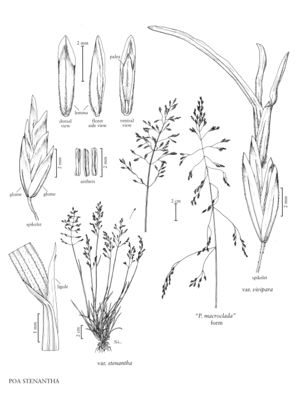familyPoaceae
subfamilyPoaceae subfam. Pooideae
tribePoaceae tribe Poeae
genusPoa
subgenusPoa subg. Poa
sectionPoa sect. Secundae
subsectionPoa subsect. Halophytae
speciesPoa stenantha
varietyPoa stenantha var. vivipara
Difference between revisions of "Poa stenantha var. vivipara"
Treatment appears in FNA Volume 24. Treatment on page 594.
FNA>Volume Importer |
FNA>Volume Importer |
||
| Line 15: | Line 15: | ||
-->{{Treatment/Body | -->{{Treatment/Body | ||
| − | |discussion=<p | + | |discussion=<p>Poa stenantha var. vivipara is the common form of the species in the Aleutian Islands; it extends eastward to Sitka, Alaska. It differs from bulbiferous forms of P. arctica (p. 529) in its lack of rhizomes, more open sheaths, and usually glaucous and scabrous panicle branches.</p> |
|tables= | |tables= | ||
|references= | |references= | ||
| Line 35: | Line 35: | ||
|publication year= | |publication year= | ||
|special status= | |special status= | ||
| − | |source xml=https:// | + | |source xml=https://bibilujan@bitbucket.org/aafc-mbb/fna-data-curation.git/src/314eb390f968962f596ae85f506b4b3db8683b1b/coarse_grained_fna_xml/V24/V24_837.xml |
|subfamily=Poaceae subfam. Pooideae | |subfamily=Poaceae subfam. Pooideae | ||
|tribe=Poaceae tribe Poeae | |tribe=Poaceae tribe Poeae | ||
Revision as of 17:10, 30 October 2019
Spikelets bulbiferous; florets bulb-forming. Glumes usually glaucous, not lustrous; anthers usually aborted late in development or not developed.
Discussion
Poa stenantha var. vivipara is the common form of the species in the Aleutian Islands; it extends eastward to Sitka, Alaska. It differs from bulbiferous forms of P. arctica (p. 529) in its lack of rhizomes, more open sheaths, and usually glaucous and scabrous panicle branches.
Selected References
None.
Lower Taxa
None.
... more about "Poa stenantha var. vivipara"
